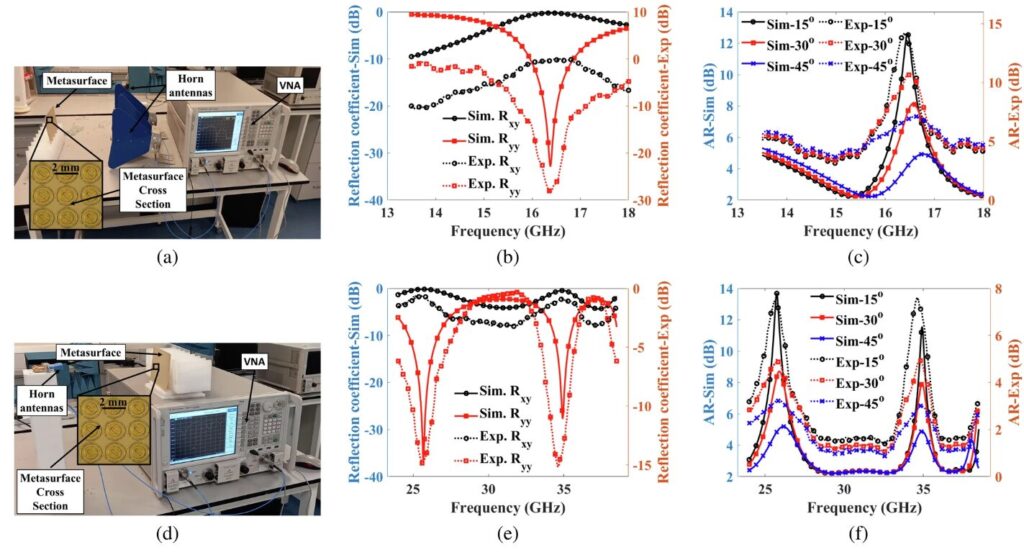
From: Multi-band ultrathin reflective metasurface for linear and circular polarization conversion in Ku, K, and Ka bands
A new, cheap, easily manufactured device could lead to improved satellite communication, high speed data transmission, and remote sensing, scientists say.
A team of engineers led by researchers from the University of Glasgow have developed an ultrathin 2D surface that harnesses the unique properties of metamaterials to manipulate and convert radio waves across the frequencies most commonly used by satellites.
Metamaterials are structures that have been carefully engineered to imbue them with properties that don’t exist in naturally occurring materials.
The team’s metamaterial, unveiled today in a new paper published in the journal Communications Engineering, could allow future generations of 6G satellites to carry more data, improve their remote sensing ability, and benefit from improved signal quality.
Current communication antennas are designed to transmit and receive electromagnetic waves oriented either vertically or horizontally—a property called linear polarization.
Misalignment between transmitting and receiving antennas can lead to signal degradation, reducing their efficiency. They are also susceptible to atmospheric effects such as rain fading and ionospheric interference, which can distort signals.
The team’s breakthrough 2D metamaterial converts the linearly polarized electromagnetic waves into circular polarization, which could improve the quality of communication between satellites and ground stations. Satellite communication with circular polarization offers enhanced reliability and performance, minimizing signal degradation from polarization mismatch and multipath interference.
Circular polarization is highly resistant to atmospheric effects like rain fading and ionospheric disturbances, ensuring stable connections. It is especially beneficial in mobile applications, as it eliminates the need for precise antenna alignment.
It also doubles channel capacity by using both right-hand and left-hand circular polarizations. This flexibility simplifies antenna design for small satellites, while improving satellite tracking and providing robust communication links in challenging environments, making it ideal for modern satellite systems.
The team’s metamaterial, which is just 0.64mm thick, is made from tiny cells of geometrically patterned copper, which is laid over a commercial circuit board commonly used in high-frequency communications.
The surface of the metamaterial is designed to allow sophisticated reflection and repolarization of electromagnetic waves. In lab tests, the 2D metamaterial surface was illuminated by signals from horn antennas and the reflected electromagnetic wave was captured using a network analyzer, which allowed the team to measure the effectiveness of the device’s conversion between linear and circular polarization. The experimental results showed a close resemblance between simulated and experimental measurements for polarization conversion to circular polarization.
Their tests also showed that the surface is capable of maintaining high performance even when radio signals glance across it at angles of up to 45 degrees—a key consideration for space applications, where perfect alignment between satellites and the surface can be fleeting.
Professor Qammer H. Abbasi, of the University of Glasgow’s James Watt School of Engineering, is the paper’s senior and corresponding author. He said, “Previous developments in metamaterials have provided new ways for electromagnetic waves to be manipulated in devices with small form factors. However, they’ve largely been limited to narrow bands of the spectrum, which has limited their practical applications so far.
“The metamaterial surface we’ve developed works across a wide range of frequencies across the Ku-, K- and Ka-bands, which span 12 GHz to 40Ghz, and are commonly used in satellite applications and remote sensing.
“This kind of 2D metamaterial surface, capable of the complex task of linear to circular polarization, can enable antennae to communicate with each other more effectively in challenging conditions.
“It could help satellites provide better signals for phones, and more stable connections for data transmission. It could also improve satellites’ ability to scan the surface of the Earth, improving our understanding of the effects of climate change or our ability to track wildlife migration.”
Dr. Humayun Zubair Khan was a visiting postdoctoral student at University of Glasgow’s James Watt School of Engineering during the development of the metamaterial surface. Now at the National University of Sciences and Technology in Pakistan, he is the first author on the paper. He said, “This is an exciting development, which outperforms previously-developed technologies by a significant margin.
“Being able to manipulate and convert electromagnetic waves with a single piece of equipment opens up a range of new potential applications across the communications sector, but particularly in the space industry, where lightweight, compact materials are prized to help keep launch payloads down.”
Professor Muhammad Imran leads the University of Glasgow’s Communications, Sensing and Imaging hub, and is a co-author of the paper. He said, “One of the most exciting aspects of the metasurface we’ve developed is that it can be easily mass-produced using conventional printed circuit board manufacturing techniques.
“That means that it can be made easily and affordably, which could help it become widely-adopted in the years to come as a valuable piece of onboard equipment for satellites.” https://techxplore.com/news/2024-09-2d-metamaterial-satellite-communication-6g.html









Recent Comments